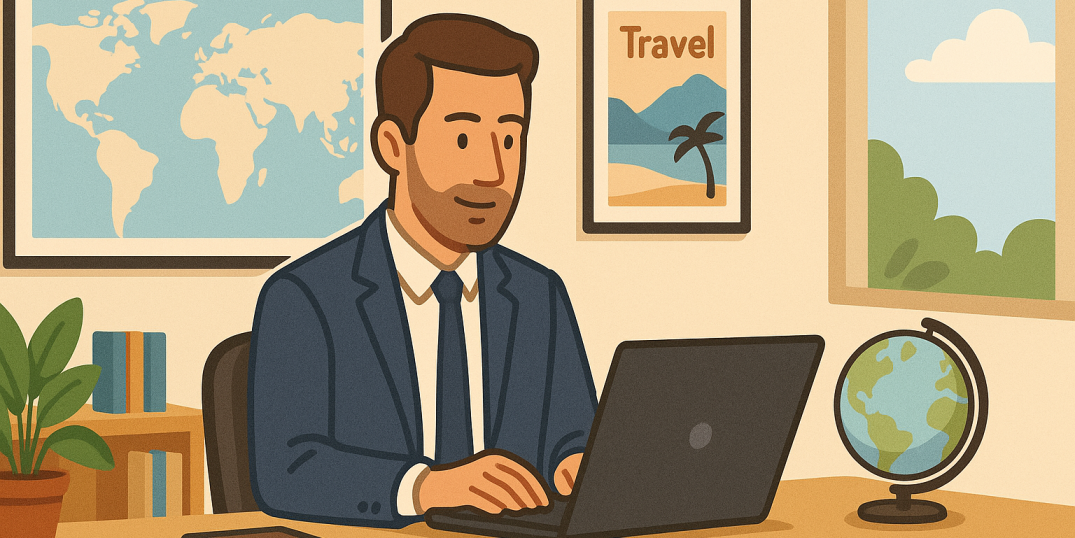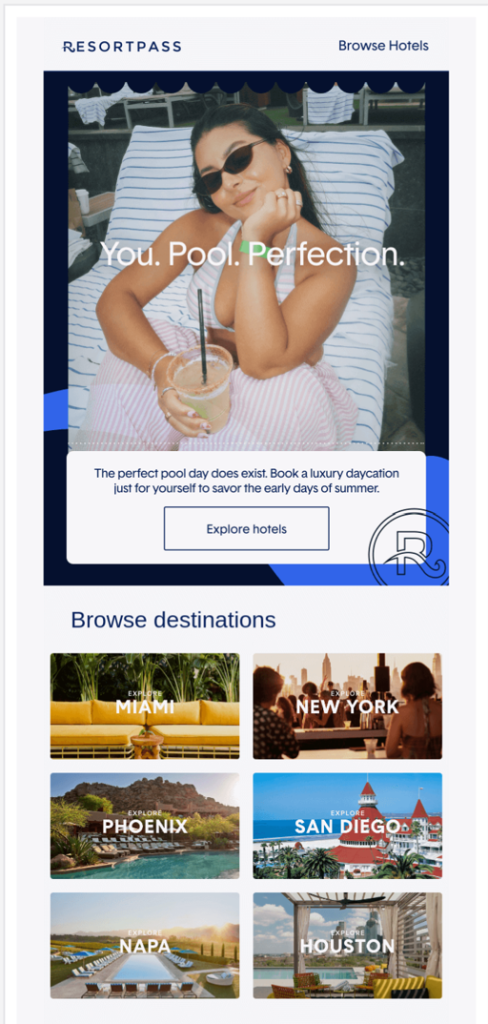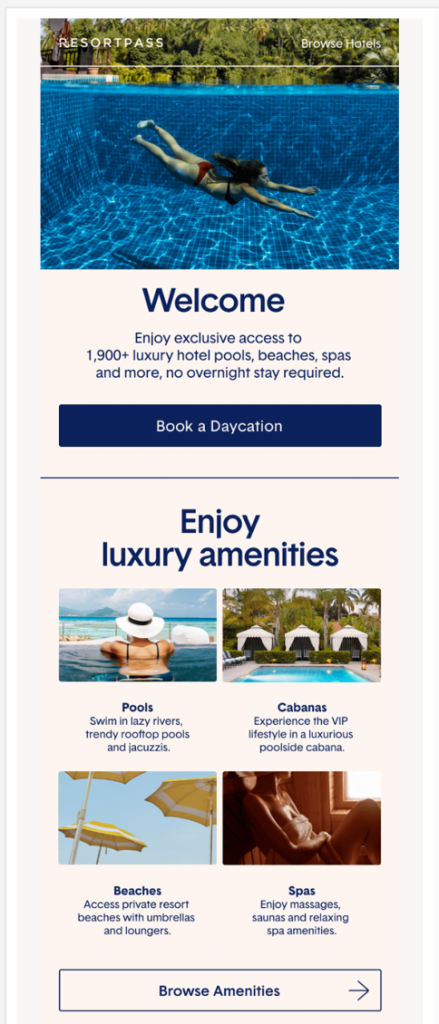- Home
- Targeted Tactics
- Email Marketing for Travel Age ...

✨ Key takeaways:
⭐ Emotions like wanderlust, nostalgia, and aspiration often outweigh logic in travel decisions.
⭐ Ethical persuasion inspires, while manipulation damages trust and long-term loyalty.
⭐ Tactics like urgency have to be genuine to work without backfiring.
⭐ Safety, flexibility, and reassurance remain powerful motivators in post-pandemic travel.
⭐ Storytelling and identity-based messaging help readers connect personally with offers.
⭐ Giving subscribers clear choices and respect for their inbox strengthens credibility.
Travel is an inherently emotional experience, so it’s no surprise that email marketing for travel agents (and travel agencies) relies heavily on stirring feelings. Travelers are driven by wanderlust—that intense urge to explore—as well as by FOMO (fear of missing out on a great deal or those Aperol Spritz moments), the need for safety, and even nostalgia for past trips. In fact, it’s emotion, not price or logic, that often spurs people to book a trip.
At the same time, there’s a fine line between persuasion and manipulation. Using psychological triggers in email marketing for travel agencies should never cross into deceit or coercion. When your audience feels respected, they reward you with repeat business and referrals. Below, we’ll explore several emotional triggers and how to use them ethically in email marketing for travel agents. From wanderlust and FOMO to reassurance and nostalgia, each trigger can boost engagement when used with care. We’ll also look at different travel agency email examples where these tactics strike the right balance and conclude with clear guidelines on where to draw the line.
Emotional Triggers That Drive Engagement in Travel Agency Emails
💎 Wanderlust & inspiration
Nothing motivates a traveler like wanderlust. Sometimes an email that can spark imagination can also plant the seed for a future trip. Travel agents often achieve this with beautiful visuals of destinations and aspirational copy.
For example, an email newsletter might showcase a full-width photo of a colorful Moroccan market, accompanied by a phrase like “Dream now, travel later.” Together, such visuals and messaging can stir a strong desire for adventure in readers.
And to be honest: the same can happen to email marketers who are supposed to write a blog article but instead look at all the amazing destinations they are supposed to write about. 😊
The key to get back on track is to make readers feel the joy of travel rather than simply pushing a sale. When you paint a vivid picture of the experience (“Imagine yourself here…”), you encourage the readers to daydream. This approach remains ethical because it’s inspirational in nature and avoids manipulation. In other words, email marketing for travel agencies should sell the experience by addressing readers’ desire for wanderlust—through inspirational imagery and copy.
💎 Fear of missing out (FOMO)
The fear of missing out is a psychological trigger that has been used in marketing for a long time. In travel email campaigns, FOMO is typically invoked through limited-time offers, scarce availability notices, and countdowns. These tactics create the natural urge to seize a rare opportunity. According to marketing research, FOMO works by creating a sense of urgency and triggering emotional decision-making. This way, people feel compelled to act fast so they don’t regret letting a great experience slip away.
While FOMO-driven campaigns can boost engagement and conversions, moderation and sincerity are crucial. Used excessively or dishonestly, FOMO can backfire. Travel marketers should ensure any urgency is genuine—for example, if you say a sale ends Friday, it really ends Friday (no fake extensions), and if you claim “last 2 seats,” there truly are limited seats. As one case study of travel emails notes, creating urgency works best when you’re transparent about time limits and when the offer is legitimately compelling. In other words, don’t cry wolf.
💎 Safety & reassurance
After the pandemic the importance of safety and reassurance in traveling became pivotal. Travel agents can address these concerns in their emails by saying, “Travel Safe: Your Well-Being Is Our Priority,” followed by details of what the company is doing to actually ensure a safe journey. Flexibility is another huge reassurance factor—in the end, travelling can be expensive. By highlighting free cancellations or “book now, decide later” packages, you take the edge off nervous travelers’ anxiety.
A good travel email might say, “Plans changed? No worries—we offer full refunds up to 24 hours before departure.” In fact, industry experts strongly recommend communicating safety in marketing messages, noting that safety has become a key aspect of travel decisions in the post-COVID era. It goes without saying that actual safety considerations should always be central—make sure that the travelers actually can enjoy a risk-free environment, and then market it accordingly.
Reassurance can take many forms in travel email marketing. Some include trust signals such as badges or certifications (e.g., the Safe Travels stamp from the WTTC). Others use testimonials: a short story from a recent customer about how comfortable they felt on their trip can be very reassuring. It’s also smart to address practical concerns: if travelers are worried about “what if” scenarios, an email could feature a brief FAQ like “What happens if regulations change? We’ll rebook you at no extra cost or give you a full refund.”
💎 Nostalgia & memory
Often, people travel to relive happy memories or reconnect with places and times that meant a lot to them. When someone receives an email saying, “Remember your childhood summers at the lake? It might be time to return to the places you loved as a kid,” it immediately pulls the reader into a personal reflection. In fact, nostalgia has become such an influential factor that “nostalgia tourism” is now recognized as a rising trend—travelers intentionally seeking destinations that let them re-experience the past.
How can travel agents use nostalgia effectively? Storytelling is key. Instead of just saying “Visit X again,” a more compelling approach is to share a relatable story or image that triggers sentimentality. For example, an email could start with: “Once upon a time, a family road trip created memories for a lifetime… Now’s your chance to share that experience with your own kids.”
Accompany that with a then-and-now photo. This helps to create an emotional pull, but more importantly, it paints the trip as a way of connecting generations and preserving traditions. And of course, sometimes it might be enough to mention Humphrey Bogart to evoke a certain feeling and persuade your clients that Casablanca in fact might be an amazing trip this fall.
💎 Aspirations & identity
Travel has a way of speaking to our aspirational self—the person we want to be or the lifestyle we dream of having. Many people see travel as part of their identity: “I’m the kind of person who… [hikes mountains/sips wine in Tuscany/volunteers in remote villages].” If your emails can acknowledge that identity, they’ll always feel welcome. For someone looking for exclusivity in travel, a message saying, “Indulge in the VIP treatment you deserve” appeals to that desire. On the other hand, for the adventure-seeking demographic, an email could read, “Are you ready to earn your adventurer badge? Conquer Kilimanjaro with us!”
Marketing strategists often suggest that travel brands identify a core emotion or value to “own” (e.g., freedom, luxury, thrill, enlightenment) and build their messaging around it. This ensures consistency and helps attract the customers whose identities align with that value.
Where to Draw the Line: Ethical Use of Emotional Triggers
👉 Avoid guilt-driven copy: Never guilt-trip your readers or make them feel like bad people for not taking a trip or clicking an offer. It means avoiding subject lines like “Don’t let your family down by staying home” or opt-out texts like “No thanks, I hate my family adventures.” Guilt is not a healthy motivator and can backfire. Instead of shaming, keep the tone positive and let people make their own choices.
👉 Don’t exploit fear or uncertainty: It’s okay to address genuine fears (like safety concerns) with facts and reassurance, but never encourage fear to push sales. In travel, this means avoiding scare tactics such as “Book now or risk never seeing the world!” or exaggerating dangers of not traveling/buying. Also, tread carefully with FOMO: urgency is one thing, outright fearmongering is another. If your email makes someone anxious or panicky, you’ve likely crossed the line.
👉 Ensure urgency is genuine: False urgency is a surefire way to lose credibility. If you’re using words like “hurry,” “last chance,” “limited time,” make sure it’s the truth. Do not use fake countdown timers or constantly extended deadlines—savvy consumers will catch on. Similarly, don’t pretend an email is personal or urgent when it’s not (e.g., subject lines like “RE: Your Booking” when the person has no booking—that’s misleading and unethical). Misleading urgency or subject line tricks might boost opens in the very short term, but they destroy trust and annoy subscribers.
👉 Always give readers a choice (clear unsubscribe options): Every email should make it easy to opt out or change preferences. So, never hide the unsubscribe link in microscopic text or use guilt-loaded opt-out messages. A visible, no-questions-asked Unsubscribe link is not only law in many places, it’s good ethics and good business. When people know they can leave your list at any time, it actually increases their trust while they are subscribed. Also, consider offering a preferences center: maybe a reader doesn’t want to quit entirely but would rather get fewer emails or only certain types (e.g., travel agency email list segments by region or interest). Giving them control (Update your email preferences here) shows you respect their inbox and choices.
Travel Agency Email Examples
Perfection just for you

This email makes an accent on individuality. For those looking for a perfect day off just for themselves, it speaks directly to that need. It offers a wide choice of pools in some of the best places where you can simply be you. For individual travelers and digital nomads, it’s ideal, as it addresses the core desire to have a day—whether for work, vacation, or rest—that’s entirely your own.

This email speaks to different types of people and a different type of pleasure—the hedonistic one. It invites readers to enjoy luxury amenities such as VIP cabanas, spas, and private resort beaches. It taps into the desire for exclusivity and does so with the right imagery. With short, precise descriptions, it encourages you to browse amenities, giving you the chance to explore the different kinds of luxury facilities that spark your interest.
Travel Agent Email Templates and Best Practices

This email template takes a more adventurous approach to Valentine’s Day, encouraging recipients to embrace different kinds of experiences on this romantic occasion. It’s a classic example of an adventure-inspired holiday email. While designed with romance in mind, it still offers a variety of locations to explore—from old castle ruins to forest escapes. Strong, evocative visuals and a range of price options make it appealing to a wide audience. Whether you’re a couple, just friends, or a group, there’s an adventure waiting here for everyone.
If you are looking for customizable email templates for any travel occasion, be sure you’ll find it in Sendigram’s collection of free HTML templates. Catered for a wide range of trips and vacations and enabled with an intuitive email editor, it allows you to create inspirational travel email campaigns of your own in just a few clicks.
To Sum Up
Emotion is a powerful engine in email marketing, especially for travel agents, capable of driving decisions and engagement. More than most other fields, travel decisions are made based on emotion: there is no matrix clients use to make their travel decision. They usually make it based on emotions, feelings, and lust—wanderlust, mostly. The key word here, however, is ethics. By harnessing feelings like inspiration and excitement honestly—and by avoiding the slippery slope of manipulation—travel marketers can build genuine connections with their audience.
Ethical emotional marketing is a win-win for everybody involved: your clients feel valued and understood, and your travel business thrives on the positive word-of-mouth and repeat business that trust creates. So go ahead—sell dreams, not just tickets—and do it in a way that would make your customers (and your conscience) smile.



